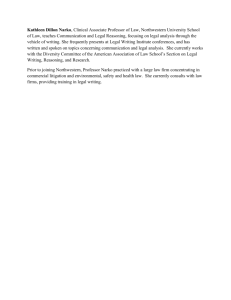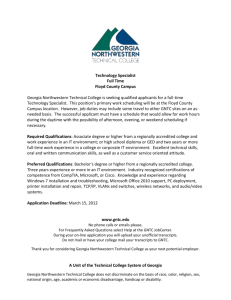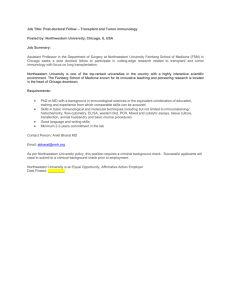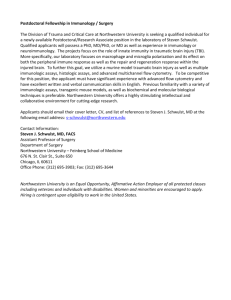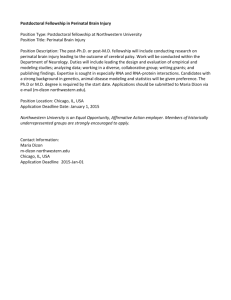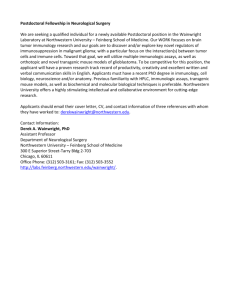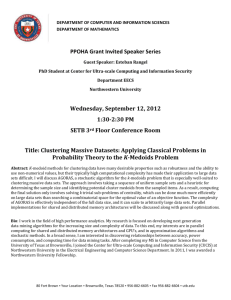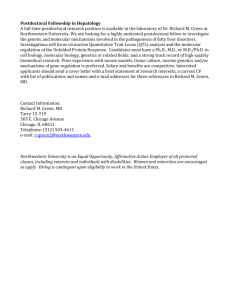STEPHANIE CHAPMAN - Northwestern University
advertisement
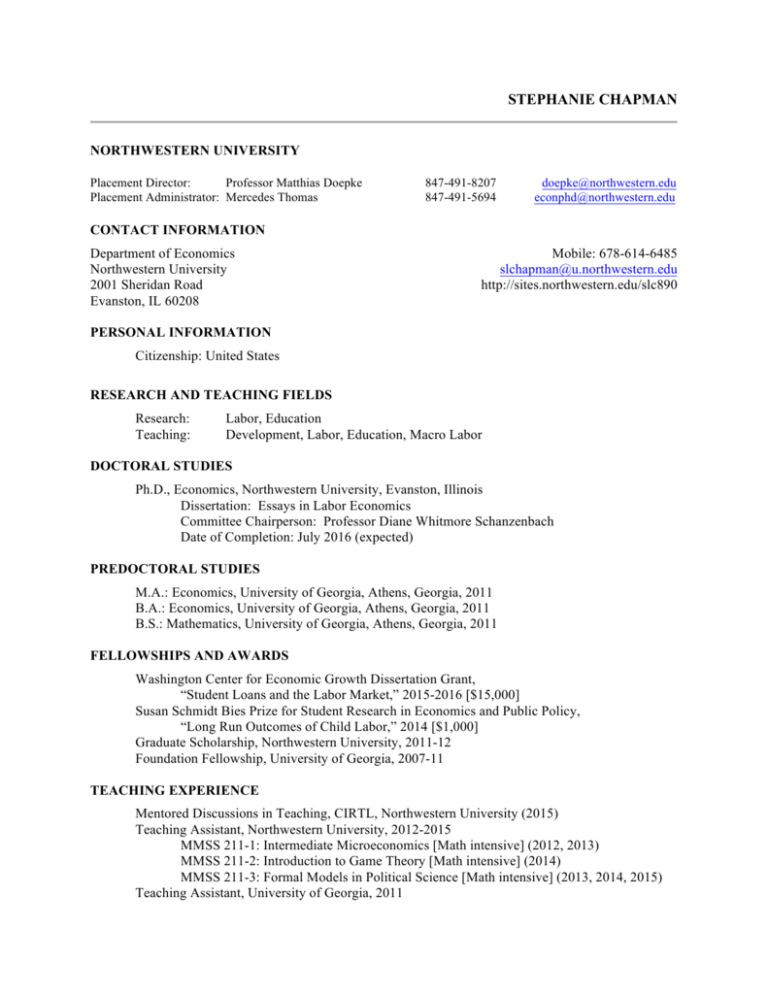
STEPHANIE CHAPMAN NORTHWESTERN UNIVERSITY Placement Director: Professor Matthias Doepke Placement Administrator: Mercedes Thomas 847-491-8207 847-491-5694 doepke@northwestern.edu econphd@northwestern.edu CONTACT INFORMATION Department of Economics Northwestern University 2001 Sheridan Road Evanston, IL 60208 Mobile: 678-614-6485 slchapman@u.northwestern.edu http://sites.northwestern.edu/slc890 PERSONAL INFORMATION Citizenship: United States RESEARCH AND TEACHING FIELDS Research: Teaching: Labor, Education Development, Labor, Education, Macro Labor DOCTORAL STUDIES Ph.D., Economics, Northwestern University, Evanston, Illinois Dissertation: Essays in Labor Economics Committee Chairperson: Professor Diane Whitmore Schanzenbach Date of Completion: July 2016 (expected) PREDOCTORAL STUDIES M.A.: Economics, University of Georgia, Athens, Georgia, 2011 B.A.: Economics, University of Georgia, Athens, Georgia, 2011 B.S.: Mathematics, University of Georgia, Athens, Georgia, 2011 FELLOWSHIPS AND AWARDS Washington Center for Economic Growth Dissertation Grant, “Student Loans and the Labor Market,” 2015-2016 [$15,000] Susan Schmidt Bies Prize for Student Research in Economics and Public Policy, “Long Run Outcomes of Child Labor,” 2014 [$1,000] Graduate Scholarship, Northwestern University, 2011-12 Foundation Fellowship, University of Georgia, 2007-11 TEACHING EXPERIENCE Mentored Discussions in Teaching, CIRTL, Northwestern University (2015) Teaching Assistant, Northwestern University, 2012-2015 MMSS 211-1: Intermediate Microeconomics [Math intensive] (2012, 2013) MMSS 211-2: Introduction to Game Theory [Math intensive] (2014) MMSS 211-3: Formal Models in Political Science [Math intensive] (2013, 2014, 2015) Teaching Assistant, University of Georgia, 2011 Stephanie Chapman, Page 2 ECON 2105: Principles of Macroeconomics (2011) ECON 2106: Principles of Microeconomics (2011) Grader, University of Georgia, 2008-09 MATH 3500H, MATH 3510H: Honors Multivariable Mathematics I & II (2008-2009) RESEARCH AND WORK EXPERIENCE Research Assistant to Professor Quincy Thomas Stewart, Institute for Policy Research, Northwestern University, 2014-15 Research Assistant to Professor Jonathan Williams, University of Georgia, 2011 JOB MARKET PAPER “Student Loans and the Labor Market: Evidence from Merit Aid Scholarships” Student loans are a growing part of the college funding equation in the US, while at the same time merit aid scholarship programs have become an increasingly popular avenue for states to subsidize higher education. I use merit aid program eligibility in thirteen states with sharp test score cutoffs to evaluate the effects of college funding on the early labor market outcomes of college graduates. I also examine the heterogeneity of the effects with respect to ability and family income. I demonstrate that the primary causal effect of qualifying for a merit aid program is to lower the loan burden of students by $5800-$7200. Eligibility has little impact on other outcomes while in school. However, students who qualify for merit aid programs have $2300$6000 lower annual income one year after graduation, and a different occupational profile four years after graduation than those who just missed qualifying for the programs. Because merit aid eligibility changes little of the college experience other than the funding package, it functions as an instrument for loans. This implies that exogenously increasing the loan burden of a college graduate by $1000 increases her annual income by $400-$800 one year after graduation. Together these results demonstrate that while merit aid scholarships may provide students with more flexibility to seek out jobs with non-pecuniary rewards, there is no detrimental financial impact of instead financing college with loans. OTHER PAPERS AND WORK IN PROGRESS “Long Run Outcomes of Child Labor” Stephanie Chapman, September 2015. In this paper I estimate the long-term individual effect of child labor using a linked census sample from 1900 and 1910 to 1940. The sample consists of over 730,000 males from the US birth cohorts of 1884 to 1904. To solve the fundamental identification problem that starting work later implies higher school achievement under compulsory education laws, I use a difference in difference strategy to exploit both changes in minimum working age laws and compulsory school start ages across fourteen states. I find that the effect of starting work a year earlier - controlling for missed school - is an increase of $8 of annual income in 1940. While modest, this effect is roughly the same as the marginal benefit of an extra year of school controlling for age of allowed labor market entry. This implies that families during this time period were likely optimally allocating the time of work eligible children between work and school. To conclude, I discuss the implications of this research for modern policy design aimed at eradicating child labor in developing countries. In particular, modern policy must account for the benefits of work to children if they intend to improve the welfare of those children. Stephanie Chapman, Page 3 “Racial wage gaps among immigrant groups” Quincy Thomas Stewart, Stephanie Chapman, Yasmiyn Irizarry, Jeffrey Dixon [in progress] It has been shown that there are wage gaps between male prime age, full time workers along racial lines, and that when controlling for observable characteristics, particularly flexibly controlling for labor market by using hierarchical linear modeling (HLM), this gap is robust to immigrant status. The wage gap between differently-raced immigrants is roughly the same as the wage gap between differently-raced native born workers (Stewart and Dixon, 2010). This project aims to more richly document these wage gaps by studying three groups less examined by the literature: subgroups of Latino and Asian individuals defined by national groups, and major racial categories of women. For the Latino and Asian subgroups, we aim to describe which subgroups are more successful at assimilating into the white American working culture, as is documented by their wage gaps with white native and foreign born men. Here we find that there is indeed significant heterogeneity across groups in the magnitude of the wage gaps that exist, indicating that some subgroups are more successful at assimilating and approaching wage parity with their white counterparts. Groups that have a higher fraction of European ancestry, such as Cubans or Columbians, have lower wage gaps and their wage gaps close more quickly after immigration than populations that have predominantly African or indigenous ancestry, such as Dominicans or Guatemalans. For women we document the racial gaps among the main racial groups (white, black, asian and latino) and explore how these gaps are similar to the wage gaps observed among men. We find that women experience more muted wage gaps by race and immigrant status relative to their male counterparts, and that the gaps along both dimensions are dwarfed by the gender wage gaps observed. We are exploring whether these muted effects are related to differences in employment and labor force participation among women from different racial and immigrant groups. “Student Loans with Income Based Repayment” Stephanie Chapman [in progress]. Per presidential order, starting in the summer of 2008 students with federal loans have access to a far more generous income-based loan repayment plan than had previously been available. This project aims to leverage this new policy as variation with two waves of the Baccalaureate and Beyond data to examine how students respond to a change in their short-term effective loan burden after all schooling decisions have been made. Previous literature suggests that such a program will significantly relax the constraints students are facing, since students seem to respond to short-term liquidity constraints. The source of variation here differs from that used in my job market paper, since here the loan burden is shifted beyond the short term whereas with state merit aid programs students take on fewer loans. A comparison of the results obtained will shed light on the mechanisms leading students to pursue different occupations and compensation, and further inform policy on how policy towards existing loans might be handled in order to minimize the impacts on income and occupational choice demonstrated in my job market paper. PROFESSIONAL ACTIVITIES Conference and Seminar Presentations: Workshop in Applied Microeconomics, Northwestern University, Oct 2015 H2D2 Research Day Conference (Poster), UM-Ann Arbor, Dec 2014 Chicago Area Workshop in Family Economics, Chicago Federal Reserve, March 2014 Refereeing: Review of Economic Dynamics Stephanie Chapman, Page 4 REFERENCES Professor Diane Schanzenbach School of Education and Social Policy Northwestern University Evanston, IL 60208 Phone: 847-491-3884 E-mail: dws@northwestern.edu Professor Matthias Doepke Department of Economics Northwestern University Evanston, IL 60208 Phone: 847-491-8207 E-mail: doepke@northwestern.edu Professor Matthew Notowidigdo Department of Economics Northwestern University Evanston, IL 60208 Phone: 847-491-8230 E-mail: noto@northwestern.edu Professor Jon Guryan School of Education and Social Policy Northwestern University Evanston, IL 60208 Phone: 847-467-7144 Email: j-guryan@northwestern.edu

